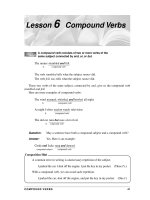Copular verbs and action verbs
Bạn đang xem bản rút gọn của tài liệu. Xem và tải ngay bản đầy đủ của tài liệu tại đây (10.88 KB, 1 trang )
Copular verbs and action verbs
In English, there are mainly two types of verbs: copular verbs and action verbs.
Copular verbs are also called linking verbs because they link the subject with a following adjective or noun. The
most common copular verb is be. It has several forms. Examples are: is, am, are, was, were, being, been etc. As
you can see, being and been are the present and past participle forms of be.
Copular verbs refer to states, rather than actions. Therefore, they are also called stative verbs.
Although copular verbs are different from action verbs, they are still considered finite verbs. And therefore, each
clause can have just one copular verb. Note that infinitives, participles and gerunds are not finite verbs.
Action verbs, on the other hand, actually describe accomplishments, achievements or activity.
Copular verbs do not state what the subject does. Instead, they show what or who the subject is.
She is an architect.
That seems impossible.
She turned pale.
The night grew dark.
The milk turned sour.
As you can see, in all of the sentences given above, the copular verb shows a certain state of the subject.
We use adjectives to modify copular verbs. Action verbs, on the other hand, are modified by adverbs.
Compare:
She drove carefully through the streets. (Here the adverb carefully modifies the action verb drove.)
She was careful as she drove through the streets. (Here the adjective careful modifies the copular verb
was.)
Stay on top of your writing! Download our grammar guide from www.englishgrammar.org to stay up-to-date.
Powered by TCPDF (www.tcpdf.org)









